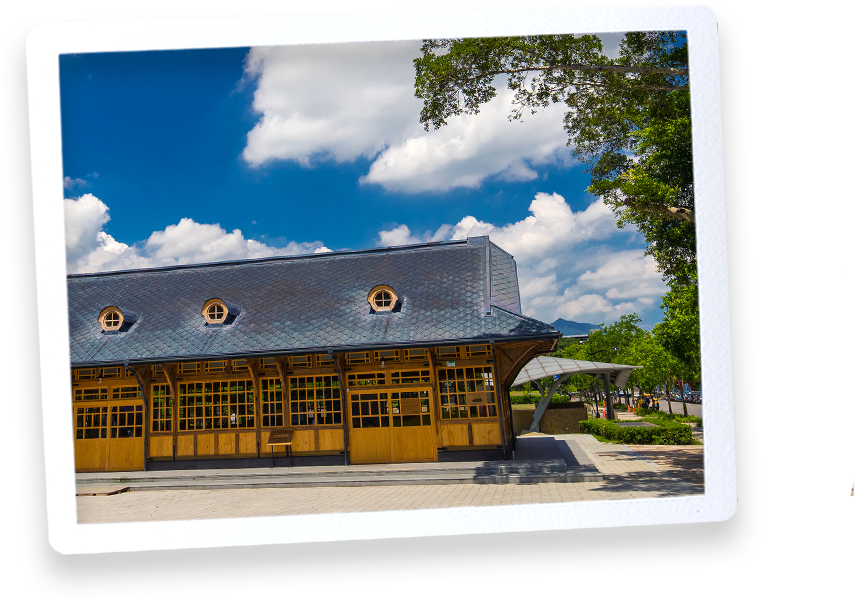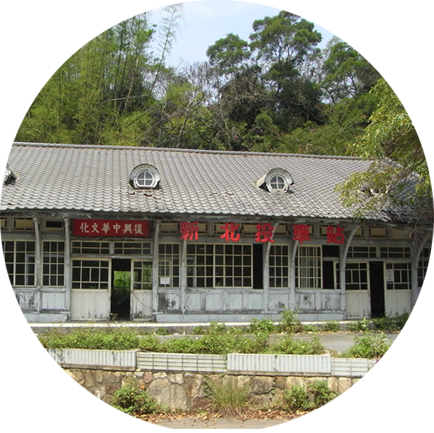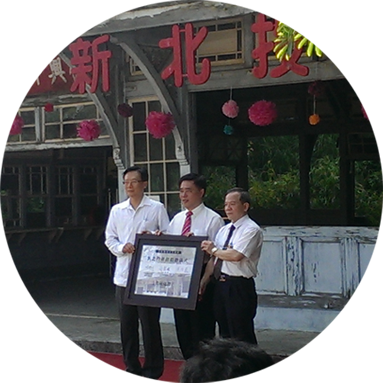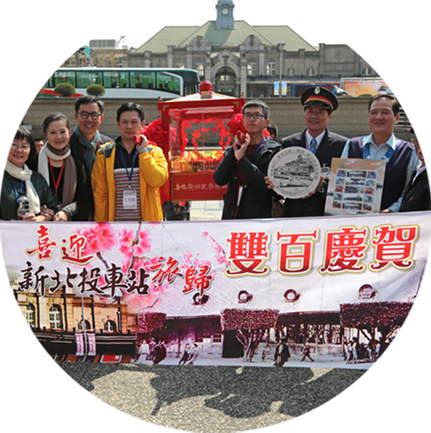Beitou Library
Apart from being famous for its hot springs, Beitou is also home to Taiwan’s first “green” library. This distinctive structure is located in the lush green environs of Beitou Hot Spring Park, near the Beitou Hot Spring Museum.This library was the first building in Taiwan to receive the certification of “Green Building”. The structure makes generous use of French windows and natural light, and blends in with the surrounding environment. Built mainly of wood and steel, it resembles a large treehouse just waiting to welcome visitors.
Ketagalan Culture Center
The Ketagalan Culture center introduces the various Pingpu indigenous tribes of Taiwan, including the now extinct northern Taiwan Ketagalan tribe. In addition to the exhibit areas, the center has an art gallery, spacious international conference room, and classroom areas serving various functions.
Beitou Hot Spring Museum
Beitou Hot Spring museum is housed in public hot spring bath built during the Japanese colonial era. The Tudor-style building has a brick and wood façade and black tile roof set picturesquely in the surrounding greenery. The building had fallen into a deep state of disrepair when local preservationists saved it from demolition. This is a good spot to learn about Beitou's rich hot spring culture and history.
Beitou Public Assembly Hall
The assembly hall was reopened to the public on December 9, 2007. In addition to a main exhibition hall (about 132 m2) and a sub gallery (about 89 m2), there is also a 978 m2 green yard. The gallery hosts various art exhibitions from time to time, and also allows the public to use it for drawing, pottery and photography exhibitions. Admission is free.
Beitou Heart Village
The Beitou Heart Village is the only military doctors’ and their dependents’ village with hot springs in Taiwan and is also one of the few remaining military dependents’ villages with a complete system in Taipei City. The architectural styles of the buildings in different periods in the village have integrated the unique historical context, the hot spring culture, and day-to-day memories of Beitou, making the village a crucial historical site in Beitou. The Taipei Culture Foundation’s team took over to manage the village in 2021 and positioned it as a site for the promotion of the culture of the military dependents’ villages in Taipei. Through regular educational activities and exhibitions in the theme of military dependents’ village, we have worked to revitalize the community and local cultural and historical resources and striven to preserve the village and redevelop it comprehensively.
Beitou Plum Garden
Built in the late 1930s, the Plum Garden, built to conform to the topography, is located in the century-old Beitou Park, and is adjacent to the Beitou Creek. It is now a historic municipal building. There used to be a hot spring bath in the house, which features a systematic sunk panel, a wooden attic, and a concrete air-raid shelter. There is a Qilian stone wall around the house, while the Qilian stones have been prohibited from being mined. It is a Japanese-and- Western-style historic structure that had witnessed wars in different periods. The Taipei Culture Foundation’s team took over to manage the structure in 2021. We will hold art exhibitions, educational activities, and other events, to continue Beitou’s unique cultural characteristics while integrating the historical, art, and cultural elements to create a space full of joy and happiness.
Thermal Valley
Located beside Beitou Hot Spring Park, Thermal Valley is one of the sources supplying the area’s hot springs. The sulfuric steam that blankets the valley year-round gives the valley a frightening quality, giving rise to nicknames like “Ghost Lake.” The springs here have the highest temperatures of any in the Datunshan volcano group. With its surreal sulfuric atmosphere, it’s no wonder Thermal Valley was considered one of the “12 great sights of Taiwan” during the Period of Japanese Occupation!
Beitou Puji Temple
Situated on Wenquan Road in Beitou District, Puji Temple is one of the few surviving Japanese-era Buddhist temples in Taiwan. It was built in 1905 with donations from railway workers and was known as Tesshin-in. Today, the temple is dedicated to Guanyin, who is locally considered to be the guardian spirit of the hot springs. In 1998, the temple was designated as an official historic site. The Japanese aesthetics of the temple are evident in the tranquil simplicity and sober design. The Japanese-style worship ceremony is continued to this day at the temple.
Xinbeitou Historic Station
In Taiwan under Japanese rule, the Xinbeitou branch railway line was constructed, and “Xinbeitou Platform” was established in 1916 (Taisho 5th year) and later renamed as “Xinbeitou Station” in order to boost the hot springs tourism in Xinbeitou region. The name of Xinbeitou just came from the name of the railway station. The building of Xinbeitou Station is the only extant one with more than a hundred years of history in the TRA Tamsui Line and even in Taipei City. With a wood-frame structure, the station is characterized by the engraved brackets under the eaves and the 3-plus-1 oeil-de-boeuf windows resulting from the expansion of the station in 1937.
Beitou Heart Village
The Beitou Heart Village is the only military doctors’ and their dependents’ village with hot springs in Taiwan and is also one of the few remaining military dependents’ villages with a complete system in Taipei City. The architectural styles of the buildings in different periods in the village have integrated the unique historical context, the hot spring culture, and day-to-day memories of Beitou, making the village a crucial historical site in Beitou. The Taipei Culture Foundation’s team took over to manage the village in 2021 and positioned it as a site for the promotion of the culture of the military dependents’ villages in Taipei. Through regular educational activities and exhibitions in the theme of military dependents’ village, we have worked to revitalize the community and local cultural and historical resources and striven to preserve the village and redevelop it comprehensively.
Beitou Museum
The Taiwan Folk Arts Museum is located in a Japanese occupation era building formerly used as the upscale Koyama Hotel and hot spring. Designated as a Taipei historic site, the two-floor wooden structure covers an area of about 2,645 square meters. The Japanese-style courtyard is elegantly landscaped, with a small bridge, stream, artificial mountain and pine trees. The building is especially evident beautiful illuminated at night.
Beitou Children's Park
"Beitou Children's Park" can be said to be the memories of Beitou people when they were young. Originally called "Public Bathing Amusement Park", it was also the first amusement park planned for children in Taiwan. It was completed in 1916. The original plan was to provide For children who come to the public baths in Beitou to relax and entertain, the facilities are simple and simple, such as grindstone slides, swings and other simple amusement facilities and other pavilions.
MRT Xinbeitou Station
Convenient transportation and beautiful environment, welcome to the Xinbeitou area, let us start from here and start playing every corner of Xinbeitou!
Yinsongge
Located in the hot spring area of Beitou, Yinsongge was built in 1934 and is a Japanese wooden hotel with a strong humanistic style. The main buildings are mostly black tiled bungalows, and the exterior landscape is extremely quiet and elegant. The wooden gatehouse, fish pond, small arch bridge, stone steps and small stone lanterns at the front entrance of the house reflect the courtyard design style of Japan during the Taisho and Showa periods. The whole hotel utilizes the terrain and arranges ornaments along the hillside, with a good view. The house is decorated with a lot of cypress wood, permeating a noble and elegant atmosphere, and it is the first historic hotel in Taiwan.
LONG NICE HOT SPRING
LONG NICE HOT SPRING was first used by people living in Beitou at that time to use natural streams to soak in hot springs along the banks of Beitou Creek. It later became an official public bath during the Japanese occupation period. It was mainly used for recuperation by Japanese soldiers. There is only male soup, and today’s male soup is the oldest appearance. LONG NICE HOT SPRING, the current building is still filled with a rare and consistent style of common people. It is the oldest Japanese-style hot spring bath in the Xinbeitou hot spring area, and it is also a hot spring bathing place for the general public to spend time and rest freely.
Beitou Park Outdoor Hot Spring Bathing Pool
The park was only opened in late 1999, on the eve of the new millennium, and is therefore also known as the "Millennium Hot Spring." The pools occupy roughly 1,000 square meters, and the area features a Japanese-style architectural design employing mostly natural materials such as stone and wood. The roof of the ticket booth and bathhouse consist of curved black tiles, which add to the classic Japanese atmosphere. One benefit of bathing in an outdoor pool is that you can enjoy the gentle breeze, the pleasant sounds of nature, and the park's lush greenery as you soak. If you choose to bathe at night, the bright moon and countless stars will accompany you as you soak away the weariness and stress of urban life.
Tiangouan HIstorical Park
Tiangouan was established in 1896 and was the first private hot spring hotel in Taiwan. It witnessed the development of Beitou's hot springs, and was later planned by the Taipei City Government as the " Tiangouan Historic Park".
Qixing Park
Qixing Park covers an area of about 3650 square meters. There is a large lawn suitable for family recreation. There is a two-story large parking lot under the park. In addition to taking the MRT, you can also drive there by yourself, which is a convenient and good choice.
Beitou Park
The Beitou Park Plaza is 61,129 square meters. There are endless stories and events in the park, where animals and plants gather. The surrounding area is more characteristic of this theme, which injects the rich history and culture of Beitou into the old Taipei area. The vitality of the newborn.





























































